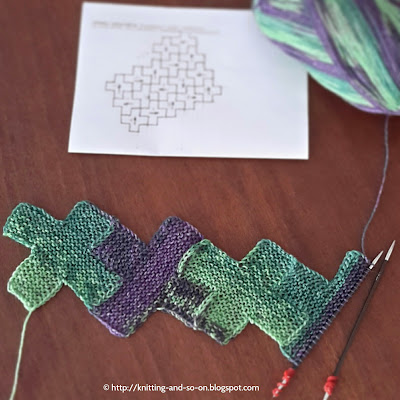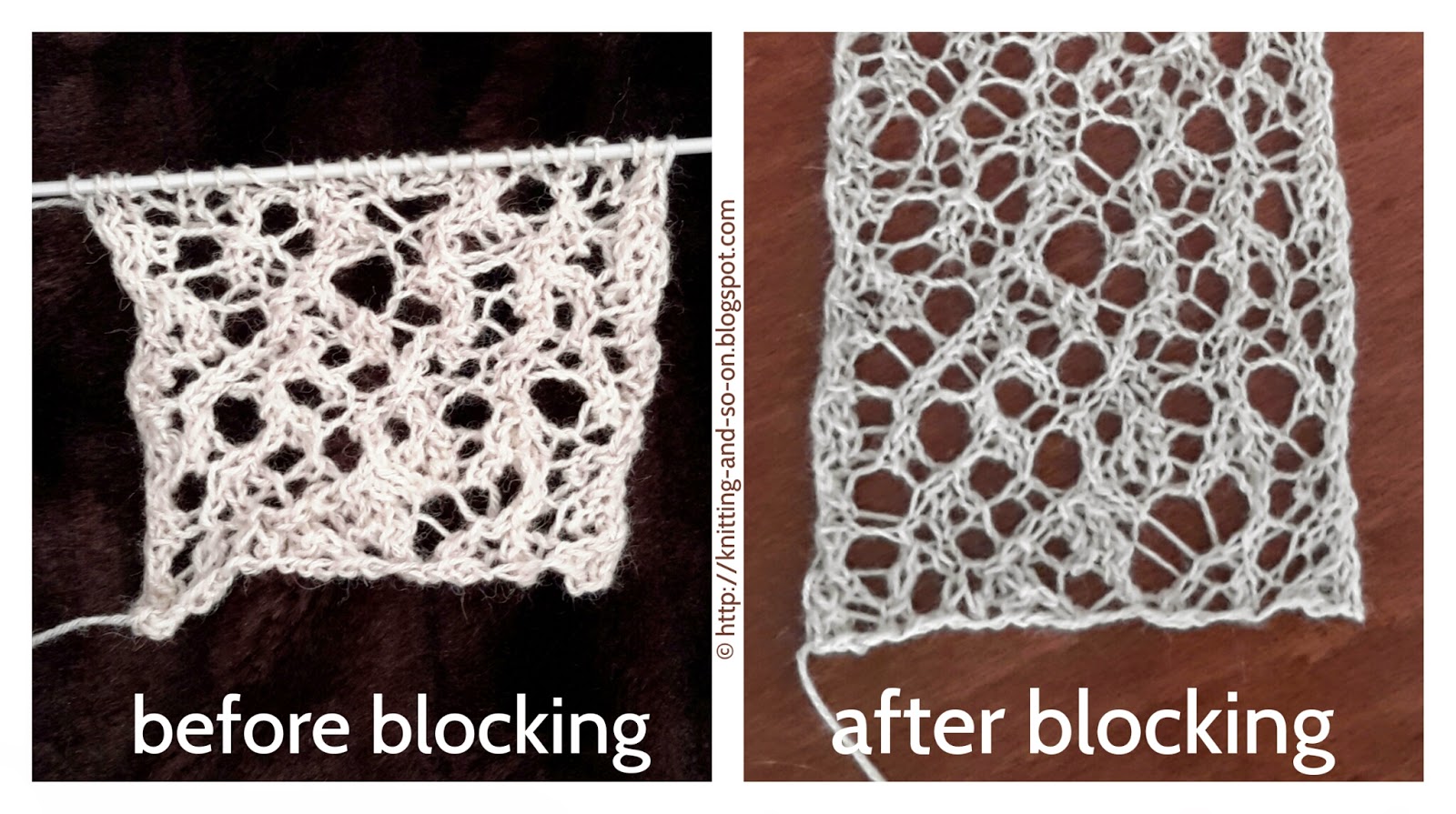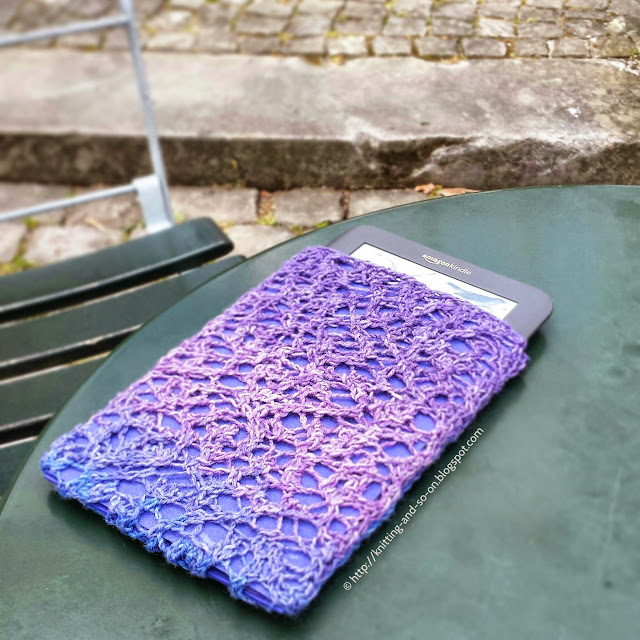Tired of wearing wintry gray? In need of something that looks strong and colorful? Then knit yourself an antidote with this nice wide scarf for spring in beautiful colors with a strong graphic pattern.
This scarf is knitted (nearly) only in garter stitch; the graphic effect is achieved with short rows.


This work by
Knitting and so on is licensed under a
Creative Commons Attribution-NonCommercial-ShareAlike 4.0 International License.

There are two versions of instructions – one (short and descriptive) that just gives the gist of what is done when. And one with rows and stitches spelled out.
Personally, I prefer instructions given in the short style (or rather that’s the way I started thinking about the pattern), but I know that instructions like this can confusing for others and are uncommon. That’s why there is a normal version as well.
Please note, that the scarf is not quite symmetrical.
Material
- about 100 grams of fingering weight yarn in Color 1 (light green on the photos)
- about 100 grams of fingering weight yarn in a contrasting color (Color 2, purple on the photos)
(the yarn used for this project is Malabrigo Sock - Colors 037 Lettuce and 141 Dewberry.)
- a circular knitting needle (3mm) or a long double pointed needle
- a tapestry needle to weave in ends
Techniques and Abbreviations
- Short rows with double stitches (German short rows, t+p): when you turn, bring yarn to the front and pull it back so that a sort of "double-stitch" is created, then knit back as usual - when you have to knit the double-stitch, make sure to knit it as one stitch (see also this YouTube video); this method has the advantage the no picking up of stitches is necessary. In the pattern, this stitch will be called t+p (turn and pull).
Instructions (Telegram Style)
- Start with 14 sts (in Color 1) and knit one wedge, slip sts to other end of needle and add 4 sts in Color 2.
- For wedges in Color 1 always start from one end of the needle; for wedges in Color 2 always start from the opposite end of the needle, i.e. slip stitches to the other end of your needles between knitting wedges.
- All stitches are knit stitches – except the first rows of Color 2 wedges (purl stitches).
- For all wedges: Start with a long row (until 5 sts before end), then knit each row 2 sts shorter, until there are only 6 or 7 sts left.
- During the first half, knit increases at the side of every 6th row (i.e. every 3rd ridge) of wedges in Color 2.
- When your piece is about half knit a wedge in Color 2 without increases or decreases
- Afterwards, knit decreases at the side of every 6th row (i.e. every 3rd ridge) of wedges in Color 2.
- End with a wedge in Color 1.
Instructions (Detailed)
Wedge 1 (Color 1)
CO14
Row 0: sl1, k to end
Ridge 1: sl1, k to 2 before end, t+p, k to end
Ridge 2: sl1, k to 2 before last double stitch, t+p, k to end
Repeat Ridge 2 until the last row is only 6 sts long (i.e. 6 on RS, 5 on WS)
Wedge 2 (Color 2)

Slip all stitches to the other end of your needle (do not turn your work) and CO4 with Color2 (see picture No. 1), then turn needle
Ridge 1: sl1, p to 5 sts before end, t+p, k to end (during the first row, make sure not to knit the double-stitches as two stitches, but as one)
Ridge 2: sl1, k to 2 sts before last double stitch, t+p, k to end
(Your piece should now look similar to the one in picture No. 2.)
Ridge 3: sl1, k to 2 sts before last double stitch, t+p, k to 2 before end, kfb, k
Continue knitting ridges 1 to 3 until the last row is only 6 or 7 stitches wide, the last ridge does not have to be a ridge 3.
Wedge 3 (Color 1)
Slip all stitches to the other end of your needle (do not turn your work) – continue knitting with Color 1
Ridge 1: sl1, k to 5 sts before end, t+p, k to end (during the first row, make sure not to knit the double-stitches as two stitches, but as one)
Ridge 2: sl1, k to 2 sts before last double stitch, t+p, k to end
Repeat Ridge 2 until the last row is only 6 or 7 sts long - after a few ridges, your piece should look similar to picture No. 3
Wedge 4 (Color 2, with increases every 3rd ridge)
Slip all stitches to the other end of your needle (do not turn your work) – continue knitting with Color 2
Ridge 1: sl1, p to 5 sts before end, t+p, k to end (during the first row, make sure not to knit the double-stitches as two stitches, but as one)
Ridge 2: sl1, k to 2 sts before last double stitch, t+p, k to end
Ridge 3: sl1, k to 2 sts before last double stitch, t+p, k to 2 before end, kfb, k
Continue knitting ridges 1 to 3 until the last row is only 6 or 7 stitches wide, the last ridge does not have to be a ridge 3.
Repeat wedges 3 and 4 until the piece measures about half the desired length of your scarf. Then knit on odd-numbered wedge (i.e. in Color 1).
Picture No. 4 shows how your piece should look after knitting wegde 3 and 4 twice.
Middle Wedge (Color 2, no increases or decreases)
Slip all stitches to the other end of your needle (do not turn your work) – continue knitting with Color 2
Ridge 1: sl1, k to 5 sts before end, t+p, k to end (during the first row, make sure not to knit the double-stitches as two stitches, but as one)
Ridge 2: sl1, k to 2 sts before last double stitch, t+p, k to end
Repeat Ridge 2 until the last row is only 6 or 7 sts long
Wedge 6 (Color 1)
Slip all stitches to the other end of your needle (do not turn your work) – continue knitting with Color 1
Ridge 1: sl1, k to 5 sts before end, t+p, k to end (during the first row, make sure not to knit the double-stitches as two stitches, but as one)
Ridge 2: sl1, k to 2 sts before last double stitch, t+p, k to end
Repeat Ridge 2 until the last row is only 6 or 7 sts long
Wedge 7 (Color 2, with decreases every 3rd ridge)
Slip all stitches to the other end of your needle (do not turn your work) – continue knitting with Color 2
Ridge 1: sl1, p to 5 sts before end, t+p, k to end (during the first row, make sure not to knit the double-stitches as two stitches, but as one)
Ridge 2: sl1, k to 2 sts before last double stitch, t+p, k to end
Ridge 3: sl1, k to 2 sts before last double stitch, t+p, k to 3 before end, ssk, k
Continue knitting ridges 1 to 3 until the last row is only 6 or 7 stitches wide, the last ridge does not have to be a ridge 3.
Repeat wedges 6 and 7 until you have knitted the same number of wegdes 6 and 7 than you did of wedges 2 and 3. End with an odd-numbered wedge (i.e. in Color 1). Bind-off all Color 1 stitches in the last row, then bind off the other stitches in Color 2.
It is possible that you don't end with the number of stitches you started with - that's because the decreasing wedges have less ridges than the corresponding increasing wedges.





























